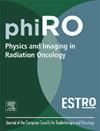混合质子计划结合了展开的布拉格峰值光束和传输光束,在保持计划质量的同时缩短了现场交付时间
IF 3.3
Q2 ONCOLOGY
引用次数: 0
摘要
背景与目的基于bragg峰的强度调制质子治疗场的递送时间对患者的吞吐量和舒适度起着重要的作用。尽管有相关的出口剂量,单层质子传输光束受益于更锐利的半影,并且传输速度极快。在本研究中,我们调查了在使用两种现场类型时,现场交付时间(FDT)和计划质量的权衡。材料与方法采用内部自动迭代优化器对8例左侧乳腺癌患者和10例口咽癌患者制定参考治疗方案。针对每种情况创建了比较混合计划。对于乳房,不同的组合传输和传统光束进行了评估。对于口咽,三个传统光束中的两个被六个传输光束取代。通过将剂量指标和FDT与参考方案进行比较来评估混合方案。结果与参考方案相比,混合方案具有器官危险(OAR)的平均剂量和最大剂量,靶剂量的均匀性和一致性,而fdt的中位数(四分位数间距)下降了58% /166 s(56 - 61%)。与参考计划相比,混合口咽计划显示出更高的平均OAR剂量,特别是口腔(中位数为34 Gy vs 31 Gy)和脊髓(20 Gy vs 11 Gy),而FDTs降低了73% /91 s(71 - 73%)。根据具体情况,混合规划可以显著减少总FDT,而对计划质量的影响有限。减少的总FDT可以改善患者的舒适度,减少治疗的总持续时间,并改善多室中心的光束调度。本文章由计算机程序翻译,如有差异,请以英文原文为准。
Hybrid proton planning combining spread-out Bragg peak beams with transmission beams to shorten field delivery times while maintaining plan quality
Background and purpose
Delivery times of Bragg-peak-based intensity-modulated proton therapy fields play an important role in patient throughput and comfort. Despite the associated exit dose, single-layer proton transmission beams benefit from sharper penumbras and are extremely fast to deliver. In this study, we investigated the trade-offs in field delivery times (FDT) and plan quality when using both field types.
Materials and methods
Reference treatment plans were created for eight left-sided breast and ten oropharynx cancer patients using an in-house automatic iterative optimizer. Comparative hybrid plans were created for each case. For breast, different combinations of transmission and conventional beams were evaluated. For oropharynx, two of the three conventional beams were replaced with six transmission beams. Hybrid plans were evaluated by comparing the dose metrics and FDT against the reference plans.
Results
Hybrid breast plans exhibited mean and maximum organ at risk (OAR) doses, and target dose homogeneity and conformity comparable to the reference plans, while their FDTs decreased by median (interquartile range) of 58 %/166 s (56–61 %). Compared to reference plans, hybrid oropharynx plans exhibited higher mean OAR dose especially to oral cavity (median of 34 Gy vs 31 Gy) and spinal cord (20 Gy vs 11 Gy), while FDTs decreased by 73 %/91 s (71–73 %).
Discussion
Depending on the case, hybrid planning can significantly reduce total FDT with only limited impact on plan quality. The reduced total FDT can improve patient comfort, reduce overall duration of the treatment, and improve beam scheduling at multi-room centers.
求助全文
通过发布文献求助,成功后即可免费获取论文全文。
去求助
来源期刊

Physics and Imaging in Radiation Oncology
Physics and Astronomy-Radiation
CiteScore
5.30
自引率
18.90%
发文量
93
审稿时长
6 weeks
 求助内容:
求助内容: 应助结果提醒方式:
应助结果提醒方式:


